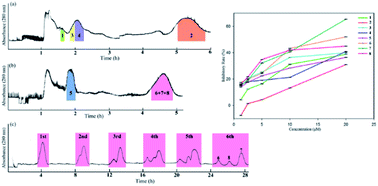An efficient method to obtain anti-inflammatory phenolic derivatives from Scindapsus officinalis (Roxb.) Schott. by a high speed counter-current chromatography coupled with a recycling mode†
Abstract
Herein, we provide an effective separation strategy based on liquid–liquid extraction and two different modes of high speed counter-current chromatography (HSCCC) for the rapid enrichment and separation of compounds from n-butanol-partitioned samples of S. officinalis. Liquid–liquid extraction of the crude sample was performed using a two-phase solvent system composed of ethyl acetate–n-butanol–water with volume ratios of 9 : 0 : 9, 5 : 4 : 9 and 3 : 6 : 9 (v/v), which allowed components with lower polarity and higher polarity to be enriched separately with the first ratio and the other two ratios, respectively. For separation, the conventional and recycling mode HSCCC were combined to develop a strategy for the acquisition of eight phenolic derivatives from the enriched samples, including one new compound, 7-O-[β-D-xylopyranosyl-(1–4)-β-D-glucopyranosyl-(1–4)-α-L-rhamnopyranosyl]-5-hydroxy-2-methyl-4H-1-benzopyran-4-one (5), three caffeoylquinic acid isomers, 3-O-caffeoylquinic acid butyl ester (6), 5-O-caffeoylquinic acid butyl ester (7), 4-O-caffeoylquinic acid butyl ester (8), salidroside (1), drynachromoside B (2), 3,4-dihydroxy-benzoic acid (3), and 5,7-dihydroxy-2-methyl chromone (4). Recycling HSCCC separation was successfully applied to separate the three isomers after six cycles. Furthermore, all the isolates were evaluated for their anti-inflammatory activity against nitric oxide (NO) production in vitro, with 6 and 7 showing significant inhibitory effects with IC50 values of 13.8 μM and 17.6 μM, respectively.



 Please wait while we load your content...
Please wait while we load your content...